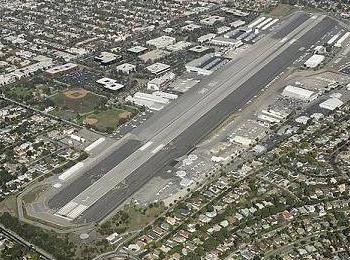
NEWSROOM
 |
NEWSROOM |
|
|
|
||||
|
FAA Concluded Santa Monica's City Ordinance In Violation By Antonio Percy |
||||
 |
May 14, 2009, Santa Monica City officials received a FAA decision by Anthony Palladino, FAA Hearing Officer which indicated the City's ban on certain category aircraft from landing and taking off was in violation of a settlement agreement entered into between the FAA and the City on January 31, 1984City officials are reviewing the 114 page decision, it is believed . the City will appeal to the Associate Administrator and that the final agency decision will be reviewed by a federal appellate court. The City asserts the ordinance does not violate the prohibition against creating an exclusive right, the FAA’s preemption claim cannot be decided in the context of the hearing held between March 16 through March 26, 2009, and that this matter should be decide by a court. This Initial Decision arises from a dispute between the Federal Aviation Administration ("FAA") Office of Airport Safety and Standards ("AAS") and the City of Santa Monica, California ("City"), the proprietor of the Santa Monica Municipal Airport. |
|||
|
More specifically, the dispute involves an ordinance enacted by the City that purports to ban certain categories of aircraft from operating at Santa Monica Municipal ( "Ordinance" Code § 10.04.06.220). Following an investigation and related proceedings conducted pursuant to regulations found at 14 C.F.R., Part 16, entitled "Rules Of Practice For Federally-Assisted Airport" the Acting Director of AAS issued a May 27, 2008 determination ("Director's Determination") concluding that the ordinance is inconsistent with the City's obligations under two assurances contained in grant agreements between the FAA and the City ("Grant Assurances"); provisions of the Surplus Property Act of 1944 and the terms of a settlement agreement entered into between the FAA and the City on January 31, 1984 ("1984 Agreement") between the parties. Finally the director's
determination also concluded the ordinance "is preempted under Federal Law." Id.
at 67. 1 This Part 16 proceeding constitutes a case of first impression before
the Hearing Officer. The instant action represents the first time the FAA has
conducted a formal investigation with regard to a safety-based restriction of
access imposed by the City (i.e., the categorical ban on use of the Airport by C
and D aircraft). The City timely requested a
hearing regarding the director's determination and a hearing officer was
appointed to conduct proceedings in accordance with Part 16; prepare findings of
fact and conclusions of law; and issue an initial decision.
|
||||
|
The Hearing Officer reviewed, took in consideration to the record evidence, the arguments of the parties and other participants,
concluded based on the findings of fact and the applicable law presented his
findings. 3. The Ordinance unreasonably
and unjustly discriminates in the operation of the Airport, and, thus, is
inconsistent with the obligations of the City under the Instrument of Transfer
of the Airport property completed pursuant to the SPA; 5. The concept of preemption provides context to consideration of whether, under the circumstances here, the City acted properly in adopting an ordinance that precludes categories of aircraft from utilizing SMO solely on the grounds of safety. The Preemption Doctrine, however, does not provide an independent basis for FAA administrative action against the City under Part 16 inasmuch as the Doctrine is not one of the enumerated "authorities" that authorize and govern Part 16 proceedings involving Federally-assisted airports. See 14 C.F.R. § 1601. The Hearing Officer stated the record establishes a violation of Grant Assurance. The City received federal funds pursuant to FAA grants under the Airport Improvement Program, and the City provided the FAA with the requisite assurance that it would "make the airport available as an airport for public use on reasonable terms and without unjust discrimination to all types, kinds and classes of aeronautical activities." FF 177. The record also establishes that the Ordinance prohibits a segment of the public from engaging in the aeronautical activity of landing or departure depending on the class, type or kind of aircraft in operation. Therefore, unless the City can prove its affirmative defense that the Ordinance was a reasonable measure based on the safety exception found, the FAA has proven that the City will violated Assurance 22 if it implements the Ordinance. The Ordinance is inconsistent with the City's obligation under Grant Assurance 22. More specifically, the Ordinance's absolute ban on use of the Airport by Category C and D Aircraft is not consistent with the City's obligation to make the airport available for public use, on reasonably terms without unjust discrimination, to all types, kinds and classes of aeronautical activities. The City has failed to establish that the Ordinance falls within the limited exception found in Subsection (i) of Grant Assurance 22. I further conclude with respect to Grant Assurance 23 that the Ordinance does not constitute the granting of an "exclusive right" within the meaning of 47 U.S.C. § 47108 (a)(4). |
| ©AvStop Online Magazine Contact Us Return To News |